Last updated on
Explore the art of harmonizing your bar stools and kitchen chairs to create a cohesive and stylish aesthetic in your home’s most convivial space.
Have you ever walked into a kitchen and been instantly drawn to the stylish combination of bar stools and kitchen chairs? The way they effortlessly coordinate, adding a touch of elegance and functionality to the space. If you’ve ever wondered how to achieve that perfect balance in your own home, you’re in luck! In this article, we’ll explore some expert tips on how to coordinate bar stools and kitchen chairs seamlessly.
Whether you’re looking to create a cohesive look or add an element of contrast, we’ve got you covered. So let’s dive right in and discover the secrets behind this artful pairing!
What's Inside
Understanding the Basics of Interior Design
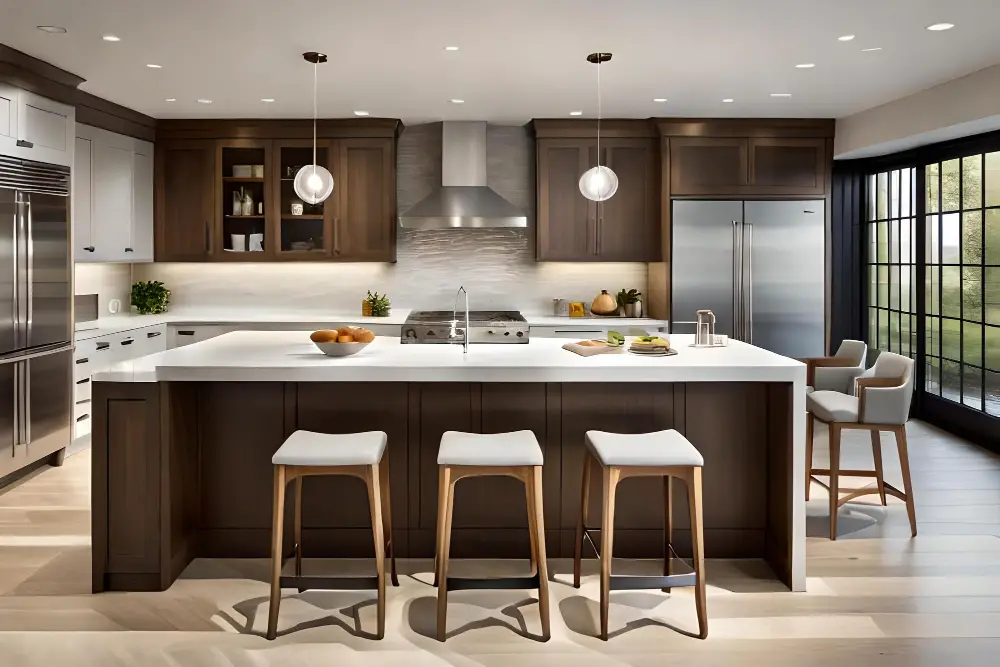
To successfully coordinate bar stools and kitchen chairs, it’s essential to have a solid understanding of the basics of interior design. Just like any other aspect of home decor, creating a cohesive and visually pleasing space requires some fundamental knowledge.
Interior design encompasses various elements such as color schemes, furniture styles, textures, and overall aesthetics. By familiarizing yourself with these basics, you’ll be better equipped to make informed decisions when selecting bar stools and kitchen chairs that complement each other flawlessly.
Understanding your own personal style preferences is crucial in this process. Are you drawn to modern minimalism or do you prefer a more traditional look? Identifying your preferred decor theme will help guide your choices when it comes to coordinating furniture pieces.
Consider the existing elements in your kitchen space that may influence your decision-making process. Take note of the colors used on walls or cabinets as well as any prominent textures or patterns already present in the room.
These factors will play an important role in determining which bar stool and chair styles will best harmonize with their surroundings.
By grasping these foundational principles of interior design before diving into selecting specific pieces for coordination purposes, you’ll set yourself up for success from the start.
Defining Your Kitchen Decor Theme
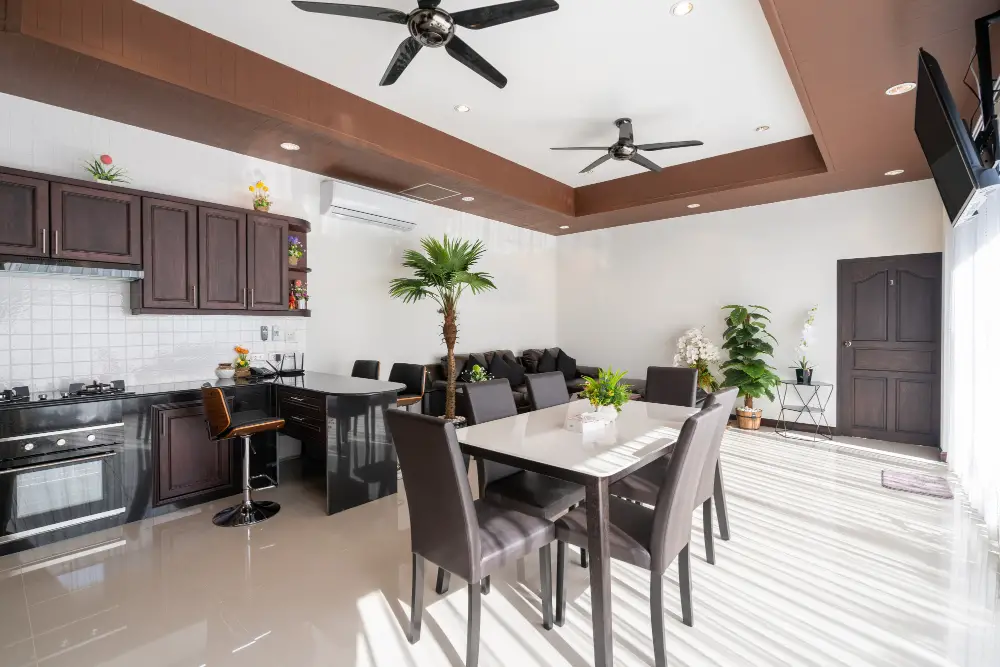
Your chosen theme will serve as a guiding principle for selecting furniture that complements the overall style of your space.
Imagine stepping into a farmhouse-inspired kitchen with its rustic charm and cozy atmosphere. In this setting, you might opt for wooden bar stools with distressed finishes or vintage-inspired metal chairs to enhance the nostalgic feel.
On the other hand, if you have a modern or minimalist kitchen design, sleek and streamlined bar stools in neutral colors can create an effortlessly chic look.
Defining your decor theme allows you to narrow down options when choosing both bar stools and kitchen chairs. It ensures that every piece contributes harmoniously to the overall aesthetic appeal of your space.
Consider elements such as color palette, materials used in cabinetry or countertops, architectural features like exposed beams or brick walls – all these factors play a role in determining which styles will work best within your chosen theme.
The Importance of Coordinating Bar Stools and Kitchen Chairs
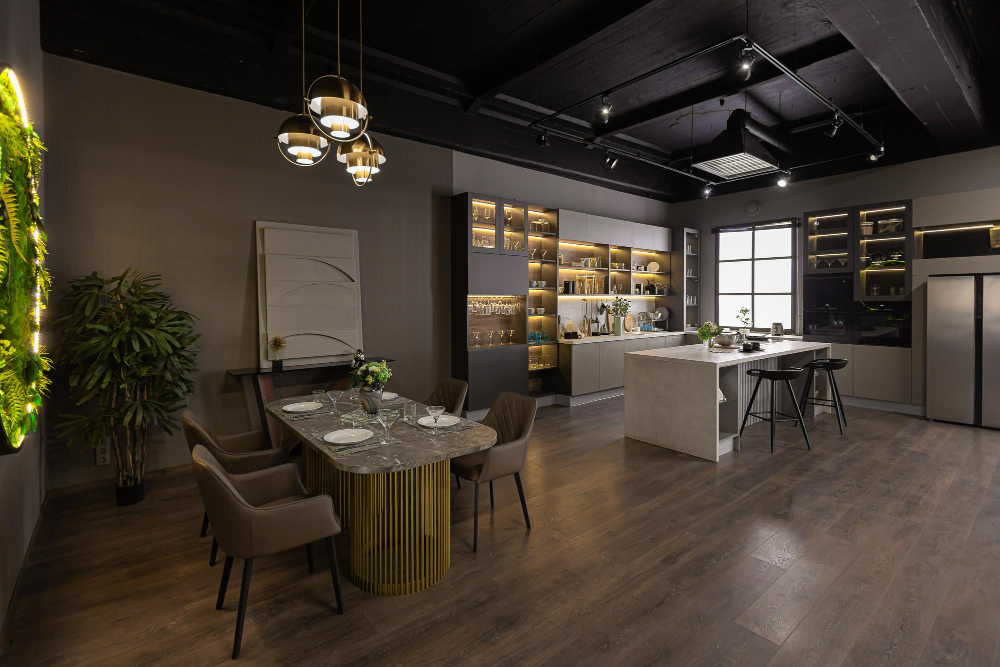
From the color scheme to the appliances, each element contributes to creating a space that is not only functional but also visually appealing. One often overlooked aspect of kitchen design is the coordination between bar stools and kitchen chairs.
Imagine walking into a beautifully designed kitchen where everything seems perfectly in place. The countertops gleam, the cabinets are meticulously organized, and there’s an inviting island with sleek bar stools that beckon you to sit down and enjoy a meal or chat with friends over drinks.
But what if those stylish bar stools clash with your mismatched set of old-fashioned wooden chairs? Suddenly, the harmony of the space is disrupted.
Coordinating your bar stools and kitchen chairs may seem like a small detail compared to other design choices you have made for your home. However, it can make all the difference in creating an atmosphere that feels cohesive and well put together.
By ensuring that both seating options complement each other in terms of style, material choice, color palette or even height – you can achieve visual balance within your kitchen area while still allowing for individuality and personal taste.
Understanding Furniture Styles
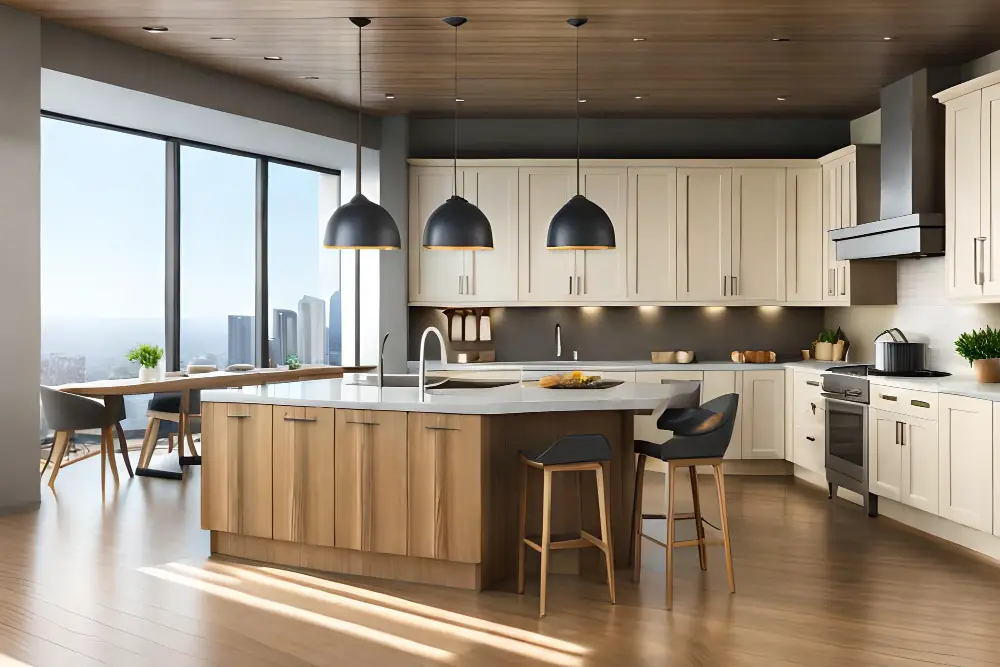
Just like any other element in interior design, furniture styles play a significant role in creating the overall look and feel of your space.
When it comes to selecting bar stools and kitchen chairs that complement each other, you’ll want to consider the existing style or theme of your kitchen decor. Are you going for a modern and sleek look? Or perhaps something more traditional with rustic charm?
Understanding different furniture styles will help you make informed choices when shopping for new pieces or trying to match existing ones. From contemporary designs featuring clean lines and minimalist aesthetics to vintage-inspired options boasting intricate details, there is an array of styles available.
By familiarizing yourself with various furniture styles such as mid-century modern, farmhouse chic, industrial loft, Scandinavian simplicity or classic elegance – just to name a few – you can narrow down your options based on what suits your personal taste best.
Remember that while coordinating bar stools and kitchen chairs doesn’t necessarily mean they have to be identical in style (in fact mixing different but complementary styles can create an interesting visual contrast), having some common elements between them will ensure they harmonize well together.
Choosing the Right Style for Your Space

First and foremost, you’ll want to take into account the overall theme or decor style of your kitchen. Is it modern and sleek? Rustic and cozy? Traditional with a touch of elegance?
By aligning your bar stools and kitchen chairs with the existing style, you can create a cohesive look that ties everything together seamlessly. For example, if you have a contemporary kitchen with clean lines and minimalist design elements, opt for bar stools and chairs that feature sleek silhouettes in materials like metal or acrylic.
On the other hand, if your kitchen exudes warmth through rustic wood finishes or farmhouse-inspired details, consider selecting bar stools made from reclaimed wood or wrought iron for an authentic touch.
Remember that while coordinating styles is important for visual harmony in your space; don’t be afraid to add some contrast as well! Mixing different styles can create an interesting dynamic within the room. Just ensure there is still some common thread tying everything together – whether it’s through color palette choices or shared design elements.
Ultimately, choosing the right style for your space involves finding balance between personal preference and what complements the overall aesthetic of your kitchen.
Importance of Color Coordination in Kitchen Furniture
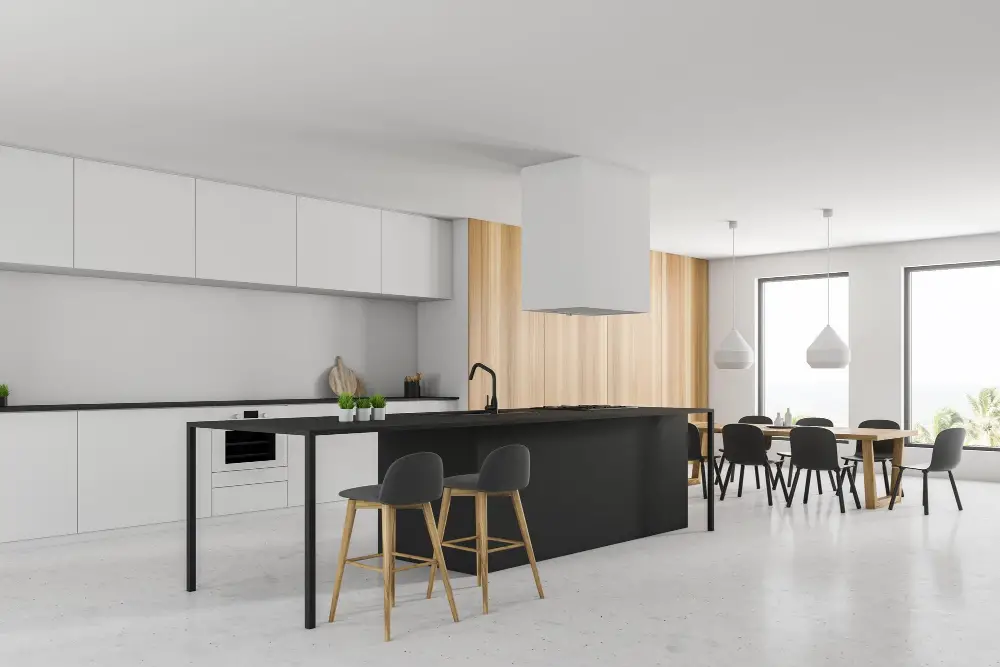
When it comes to bar stools and kitchen chairs, selecting the right colors can make all the difference in achieving a cohesive look.
Imagine walking into a kitchen where the bar stools and chairs seamlessly blend with the overall color scheme. The soft hues of pastel blue on your coastal-themed bar stools perfectly complementing the white farmhouse-style chairs around your rustic wooden dining table.
The result is an inviting atmosphere that exudes charm and sophistication.
On the other hand, mismatched colors can create visual chaos, disrupting the flow of your kitchen decor. Picture vibrant red bar stools clashing with sleek black leather dining chairs or bold patterns overwhelming each other instead of working together harmoniously.
To ensure successful color coordination, start by defining your desired color palette for your entire kitchen space. Consider factors such as wall paint or wallpaper, cabinetry finishes, countertop materials, backsplash tiles – everything that contributes to establishing an overall aesthetic theme.
Once you have established this foundation for your color scheme, select complementary or contrasting shades for both your bar stools and kitchen chairs accordingly. Complementary colors lie opposite each other on the color wheel (e.g., blue-orange), while contrasting colors are adjacent (e.g., blue-green).
Both approaches can be effective depending on whether you want to create harmony through matching tones or add visual interest through contrast.
Remember also to consider texture when coordinating colors – smooth leather upholstery may pair well with matte-finished metal frames while fabric-covered seats could enhance wooden chair legs beautifully. By paying attention to these details during selection process will help you achieve stunning results in terms of aesthetics without compromising functionality.
Colors and Textures: Creating a Harmonic Environment

By carefully selecting complementary hues and incorporating varied textures, you can create a harmonious environment that exudes style and sophistication.
Imagine walking into a kitchen where the bar stools seamlessly blend with the texture of your kitchen chairs. The smooth leather upholstery on your bar stools complements the sleek wooden finish of your dining chairs, creating an inviting atmosphere for family gatherings or entertaining guests.
To achieve this level of coordination in colors and textures, start by considering your existing decor theme. If you have a modern minimalist design scheme in place, opt for clean lines with monochromatic tones such as black or white.
This will ensure that both your bar stools and kitchen chairs contribute to an uncluttered aesthetic while maintaining visual harmony.
On the other hand, if you prefer a more eclectic vibe in your kitchen space, don’t be afraid to mix different materials like metal frames paired with upholstered seats or even rattan accents combined with wooden elements. These combinations add depth to your decor while still maintaining balance through thoughtful color choices.
Remember that color coordination doesn’t necessarily mean everything has to match perfectly; sometimes contrasting shades can create visual interest when done right. For example: pairing vibrant red bar stools against neutral-toned dining chairs adds an unexpected pop without overwhelming the space.
Textures play just as important a role as colors when it comes to creating harmony within any room’s design scheme – including kitchens! Consider mixing smooth surfaces like leather or velvet upholstery on some seating options alongside textured fabrics such as tweed or linen on others for added dimensionality throughout. By thoughtfully combining various textures within both types of seating arrangements (barstools & dining), you’ll achieve not only visual appeal but also tactile comfort – making every mealtime experience enjoyable!
Coordinating colors and playing around with textures is key to creating a harmonious environment. By carefully selecting complementary hues and incorporating varied textures, you can achieve a cohesive look that elevates the overall aesthetic of your kitchen.
Texture Matching 101

Just like colors, textures can either complement or clash with each other, so it’s important to choose wisely.
Texture refers to the surface quality of an object or material. It can range from smooth and sleek to rough and tactile.
By incorporating different textures into your kitchen design, you add depth and visual interest.
To achieve successful texture matching between your bar stools and kitchen chairs, consider the existing textures in your space. If you have wooden cabinets or countertops with a grainy texture, opt for bar stools or chairs that feature similar wood grains for consistency.
On the other hand, if you have smooth marble surfaces in your kitchen area, consider choosing upholstered seats for both the bar stools and chairs. The softness of fabric against the coolness of marble creates an intriguing contrast that adds warmth without overwhelming the overall aesthetic.
Remember not to go overboard with too many contrasting textures as this may create visual chaos rather than harmony. Aim for balance by selecting two or three complementary textural elements throughout your space.
Choosing the Right Kitchen Chairs
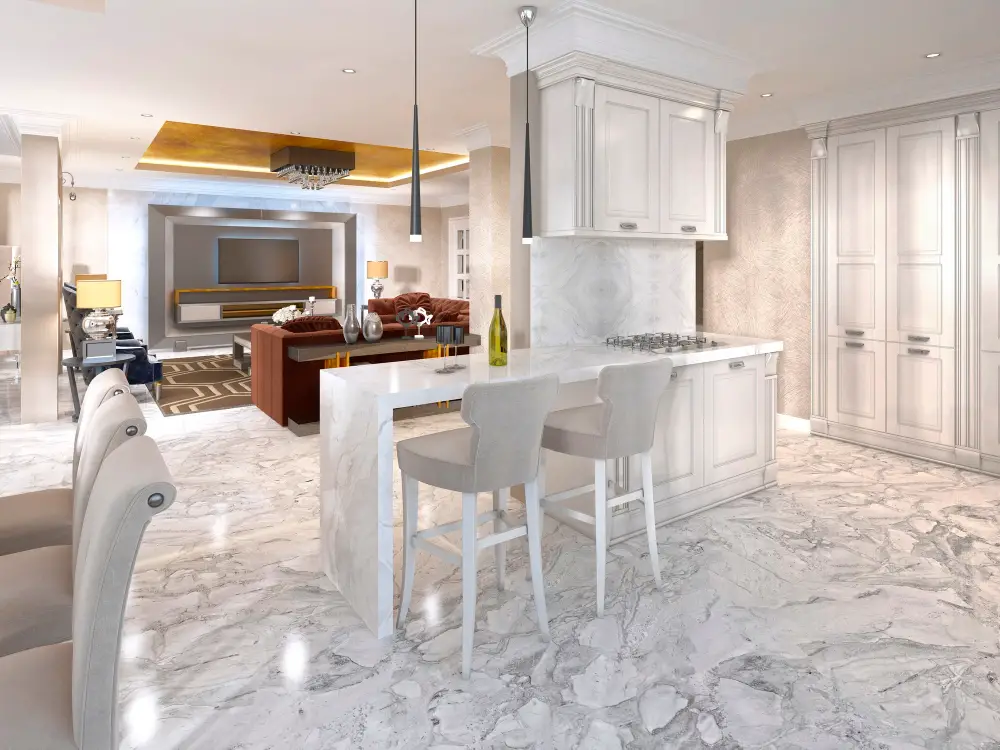
After all, these chairs will not only be used for dining but also serve as an integral part of your kitchen’s overall design. So let’s delve into some essential tips that will help you make the best choice.
First and foremost, think about the style and theme of your kitchen decor. Are you going for a modern look with sleek lines and minimalist designs? Or perhaps a rustic farmhouse vibe with distressed wood finishes? Understanding your desired aesthetic will guide you in selecting chairs that complement the overall ambiance.
Next, consider comfort. Since kitchens often double as gathering spaces where family members or guests can relax while meals are being prepared or conversations flow freely, comfortable seating is crucial.
Look for chairs with padded seats or ergonomic designs that provide ample support during extended periods of sitting.
Another important aspect is size and scale. Take measurements of your dining area to ensure proper fit without overcrowding the space or leaving it feeling empty.
Consider both height (to match table height) and width (to allow enough elbow room). Remember: functionality should never be compromised in pursuit of style!
Material selection plays a significant role too – durability matters! Opting for materials like solid wood or metal ensures longevity even under heavy use conditions common in busy kitchens.
Lastly, don’t forget about maintenance requirements when making your decision – especially if spills are likely to occur frequently! Choose fabrics that resist stains easily cleaned up by wiping them off quickly; alternatively go for leatherette upholstery which offers easy cleaning options too!
Deciding On the Appropriate Height for Bar Stools and Chairs

The height not only affects the overall visual appeal but also determines how comfortable and functional they will be in your kitchen space.
Imagine this: you’ve carefully selected a set of stunning bar stools that perfectly complement your kitchen’s decor theme. However, when you bring them home, you realize they are too tall or too short for your counter or island.
Suddenly, the harmony you envisioned is disrupted.
To avoid such a scenario, it’s essential to measure the height of your counter or island before purchasing any seating options. For standard countertops that are around 36 inches high, bar stools with a seat height between 24-26 inches would be ideal.
This allows enough legroom while providing comfortable seating at an appropriate level.
On the other hand, if you have a higher countertop measuring around 42 inches in height (commonly found in breakfast bars), opt for taller bar stools with seat heights ranging from 28-30 inches. These taller options ensure proper alignment with the elevated surface while maintaining comfort and functionality.
For kitchen chairs used at dining tables or as additional seating near islands without raised counters, aim for chair heights that allow individuals’ feet to rest comfortably on the floor when seated – typically around 18-20 inches from floor to seat.
Tips for Bar Stool Selection

First and foremost, think about the overall style and theme of your kitchen decor. Are you going for a modern look with sleek lines and minimalist design? Or perhaps you prefer a more rustic or traditional feel? Understanding your desired aesthetic will help guide you in choosing bar stools that complement the existing elements in your space.
Next, take into account the height of both your counter or bar area and the intended users. Bar stools come in various heights, so it’s crucial to select ones that provide comfortable seating while allowing enough legroom underneath.
As a general rule of thumb, aim for around 10-12 inches between the top surface of your counter/bar and the seat height.
Consider materials as well – do you want wooden bar stools that add warmth or metal ones with an industrial edge? Each material has its own unique charm but also requires different maintenance levels.
Another important aspect is functionality. Do you need swivel seats for easy movement or backrests for added comfort during long meals? Think about how often these seats will be used and what features would enhance their usability within your daily routine.
Lastly, don’t forget about color coordination! Matching or complementing colors can tie together all elements seamlessly while adding visual interest to space.
Material Choices: From Wood to Metal
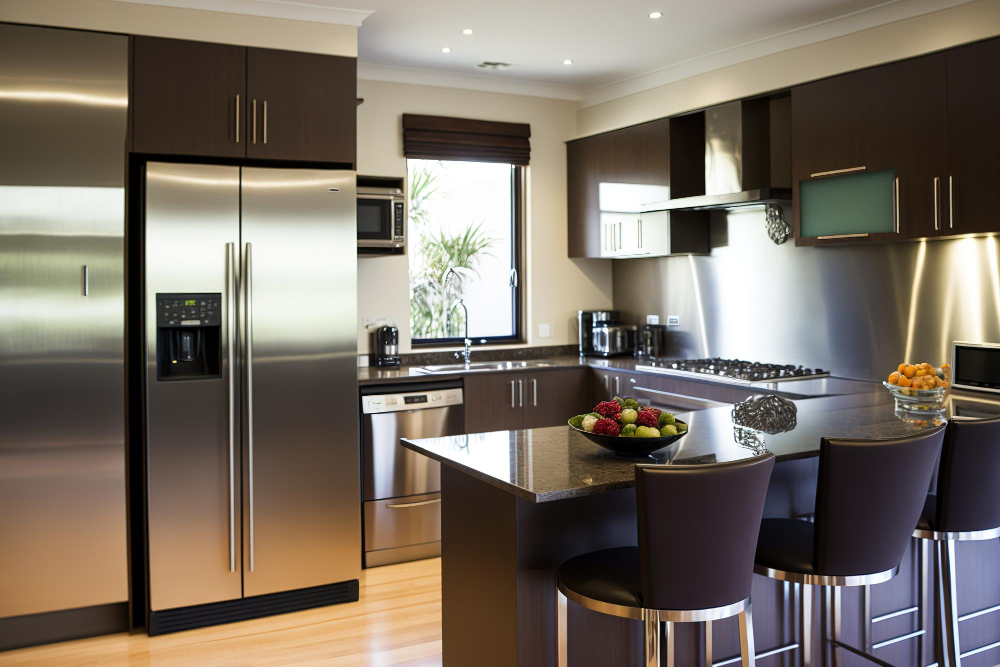
The materials you select can greatly impact the overall look and feel of your space. From warm and inviting wood to sleek and modern metal, each material brings its own unique charm.
Wooden bar stools and kitchen chairs exude a timeless elegance that can effortlessly blend with various decor styles. Whether you opt for rich mahogany or light oak, wooden furniture adds warmth and character to any kitchen setting.
It pairs beautifully with farmhouse-inspired kitchens as well as traditional or rustic designs.
On the other hand, if you’re aiming for a more contemporary aesthetic, metal bar stools or chairs might be just what you need. Metal offers a sleekness that complements modern kitchens perfectly.
Stainless steel provides an industrial vibe while brushed aluminum lends itself well to minimalist spaces.
Of course, there are also options beyond wood and metal! Upholstered seats in fabric or leather add comfort while introducing texture into your design scheme. Wicker or rattan seating brings a touch of natural beauty ideal for coastal-themed kitchens.
When selecting materials for your bar stools and kitchen chairs, keep in mind factors such as durability (especially if they will be heavily used), ease of cleaning/maintenance requirements based on personal preferences (e.g., spills happen!), as well as how they fit within your overall budget considerations.
Remember: it’s not just about choosing one type of material; mixing different materials can create visual interest too! For instance combining wood with metal accents creates an appealing contrast that adds depth to your space.
Incorporating Bar Stools and Kitchen Chairs Into the Overall Decor
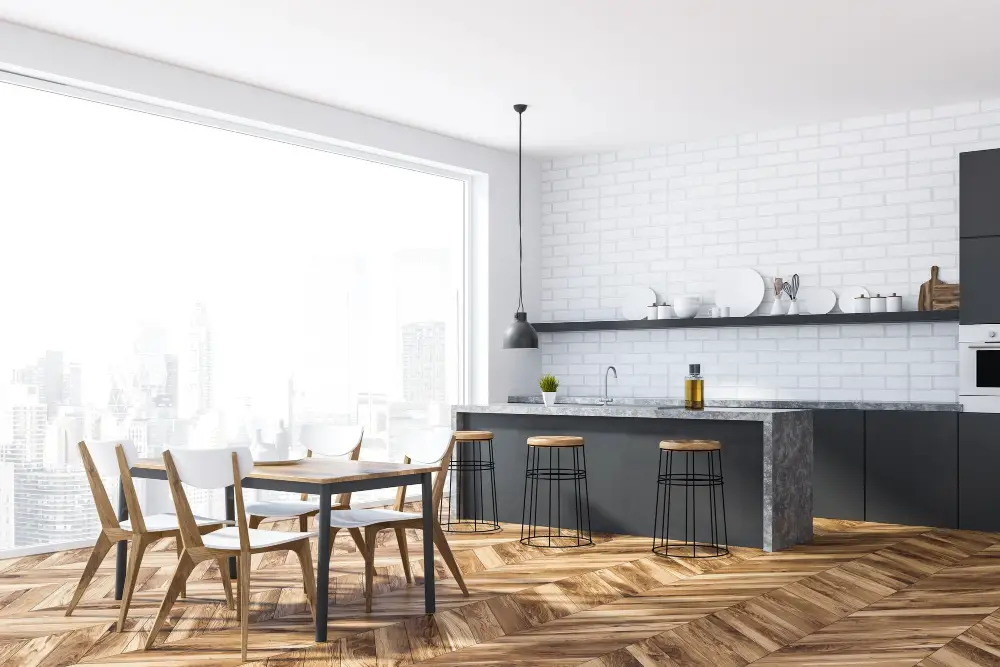
This step is crucial in ensuring a cohesive and visually appealing space.
One effective way to incorporate these furniture pieces into your overall decor is by considering their design elements. If you have a modern or minimalist kitchen, opt for sleek and streamlined bar stools and chairs with clean lines.
On the other hand, if your kitchen has a more traditional or rustic vibe, choose bar stools and chairs with warm wood finishes or intricate detailing.
Another aspect to consider when incorporating these furniture pieces is color coordination. Take cues from existing colors in your kitchen such as cabinetry, countertops, or backsplash tiles.
You can either match the colors of your bar stools and chairs directly to these elements for a harmonious look or create contrast by selecting complementary shades.
In addition to design elements and color coordination, think about how you can use accessories like cushions or seat covers on both the bar stools and chairs to tie everything together visually. These small details can make a big impact on creating an integrated look within your space.
Lastly, don’t forget about functionality! Ensure that both the bar stools at your counter area as well as any additional seating around dining tables are comfortable enough for extended periods of sitting while still aligning with their respective styles.
Using Bar Stools and Chairs to Define Your Kitchen Space

These furniture pieces not only serve as functional seating options but also play a crucial role in establishing the overall ambiance of your kitchen.
By strategically placing bar stools at a breakfast counter or island, you create an inviting area for family and friends to gather while meals are being prepared. The height of the bar stools can help delineate this space from the rest of the kitchen, giving it a distinct purpose.
Similarly, using chairs around a dining table helps establish an intimate setting for enjoying meals together. The style and design of these chairs can further enhance your desired atmosphere – whether it be rustic farmhouse charm or sleek modern elegance.
Consider how different materials and finishes contribute to defining your kitchen space as well. For instance, if you have opted for wooden furniture with warm tones throughout your entire home decor scheme, continuing this theme with matching wood bar stools and chairs will create visual harmony within the room.
On the other hand, contrasting materials like metal or acrylic can add an element of contemporary flair when paired with traditional cabinetry or vice versa. This juxtaposition creates interest while still maintaining cohesion within your overall design concept.
Remember that lighting also plays its part in highlighting these key areas where bar stools and chairs are placed. Pendant lights above counters or chandeliers over dining tables draw attention to these spaces while providing ample illumination during meal times.
Tips On Balancing Functionality and Aesthetics
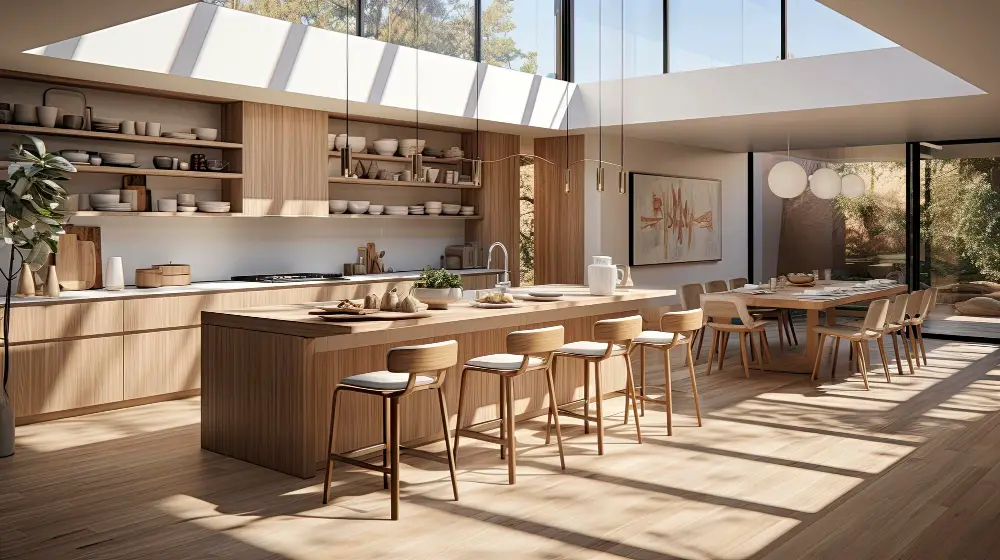
After all, you want your seating options to not only look great but also serve their purpose in a practical way.
To achieve this delicate equilibrium, consider the following tips:
1. Comfort is Key: While aesthetics are important, never compromise on comfort.
Look for bar stools and kitchen chairs that offer adequate support with cushioning or ergonomic design features. This ensures that your family and guests can enjoy meals or conversations comfortably.
2. Consider Space Constraints: Take into account the size of your kitchen or dining area when selecting bar stools and chairs.
Opt for sleek designs if you have limited space to avoid overcrowding while still maintaining an appealing aesthetic.
3. Cohesive Design Elements: Aim for consistency in design elements such as color palette, materials used, or overall style between your bar stools and kitchen chairs.
This creates a cohesive look throughout the space without sacrificing functionality.
4.Combining Different Heights: If you have both a counter-height island/bar as well as a standard-height dining table in close proximity within your kitchen area – don’t be afraid to mix things up! Combining different heights of seating options can add visual interest while ensuring each area serves its intended purpose effectively.
5. Think About Storage Solutions: Functionality extends beyond just sitting comfortably; it also involves storage considerations. Look for stackable or foldable options if storage space is limited so that they can be easily stored away when not in use.
By keeping these tips in mind during the selection process ,you’ll strike an ideal balance between functionality (comfortability & practicality)and aesthetics (visual appeal & cohesiveness).
Handling Challenges: When Bar Stools and Kitchen Chairs Don’t Match
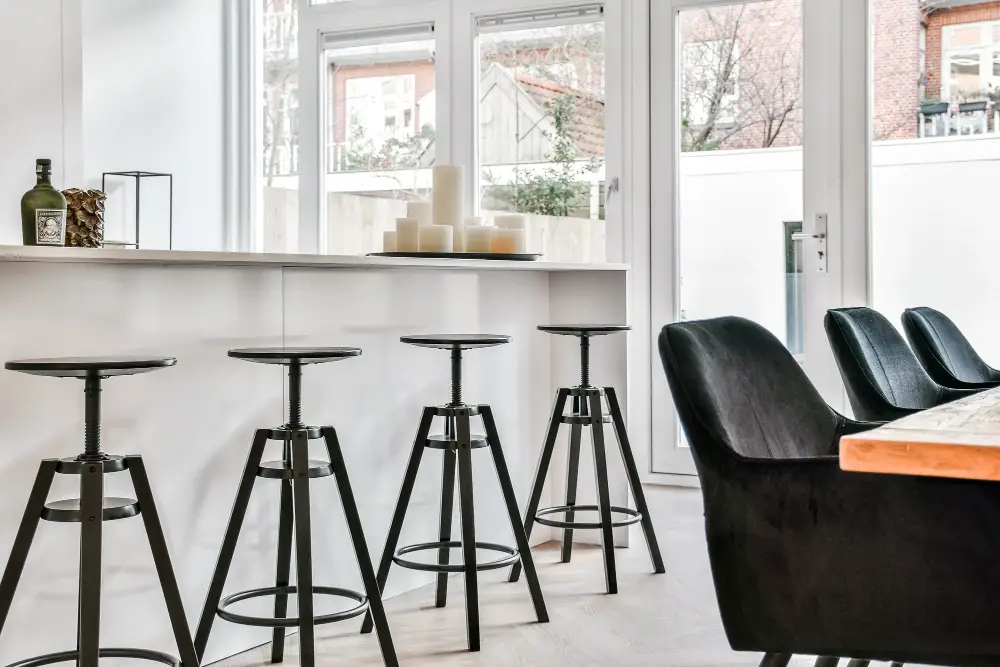
Fear not! There are ways to handle this challenge with grace.
One option is to embrace the concept of intentional mismatching. Mixing different styles or materials intentionally can add an eclectic charm to your kitchen decor.
For example, pairing rustic wooden bar stools with sleek modern chairs can create an interesting contrast that adds character to the space.
Another approach is to focus on finding common elements between the two pieces. Look for shared design features such as similar colors or shapes that tie them together visually.
This way, even if they don’t match exactly, there will still be a sense of cohesion in their overall appearance.
If you’re unable to find any similarities between your existing bar stools and kitchen chairs, consider incorporating other elements into your kitchen design that help bridge the gap. Adding complementary accessories like cushions or seat covers in coordinating colors can bring harmony while also providing comfort.
Remember, sometimes embracing imperfections and celebrating individuality can result in a unique and personalized aesthetic for your home’s gathering space.
Cost Considerations When Coordinating Bar Stools and Kitchen Chairs

After all, you want to achieve a stylish look without breaking the bank. Fortunately, there are various cost considerations that can help guide your decision-making process.
Firstly, determine your budget before embarking on your search for bar stools and kitchen chairs. This will give you a clear idea of how much you’re willing to spend and prevent any overspending or impulse purchases.
Next, consider the materials used in the construction of both bar stools and kitchen chairs. Different materials come with different price tags attached.
For example, solid wood tends to be more expensive than metal or plastic options.
Keep an eye out for sales or discounts at furniture stores or online retailers. Timing your purchase strategically can save you some money while still allowing you to find high-quality pieces that fit within your desired aesthetic.
Another option worth exploring is second-hand furniture stores or online marketplaces where gently used items are available at lower prices compared to brand new ones. With some patience and persistence in searching through these platforms, you may stumble upon hidden gems that perfectly match what you envision for your space.
Lastly but importantly – don’t forget about quality! While it’s tempting sometimes just go for the cheapest option available; investing in well-made bar stools and kitchen chairs will ensure their longevity over time – saving money on replacements down the line.
Essential Tips for Purchasing Bar Stools and Kitchen Chairs

After all, investing in furniture is an important decision that can greatly impact the overall look and feel of your kitchen.
Firstly, consider the style and design of your existing kitchen decor. Are you going for a modern or traditional look? This will guide you in selecting bar stools and chairs that complement your chosen aesthetic.
Look for pieces with similar lines, shapes, or materials to create a cohesive visual appeal.
Next, think about functionality. How often do you entertain guests? Do you have children who will be using these seats regularly? Opting for durable materials like wood or metal can ensure longevity while also being easy to clean.
Height is another crucial factor when choosing bar stools. Measure the height of your counter or island before making any purchases to ensure proper seating alignment with countertops – nothing ruins comfort more than having knees bump into surfaces!
Don’t forget about comfort! Consider features such as cushioned seats or backrests if relaxation is high on your priority list.
Lastly but importantly: budget considerations should not be overlooked either! Determine how much you’re willing to spend on these furnishings beforehand so that it doesn’t become an overwhelming expense later on.
How to Clean and Maintain Your Bar Stools and Kitchen Chairs

Regular cleaning and maintenance will not only preserve their appearance but also extend their lifespan. So, let’s dive into some essential tips on how to clean and maintain these key pieces of furniture.
When it comes to cleaning, start by checking the manufacturer’s instructions for any specific recommendations or restrictions. For most materials like wood or metal, a gentle wipe-down with a damp cloth is usually sufficient for day-to-day maintenance.
Avoid using harsh chemicals that can damage the finish or upholstery.
For upholstered seats or cushions on your bar stools and kitchen chairs, regular vacuuming will help remove dust and debris that can accumulate over time. If there are any spills or stains, address them promptly by blotting gently with a clean cloth before they have a chance to set in.
To tackle tougher stains on upholstery fabric such as wine spills or food splatters, use mild soap mixed with water as per the manufacturer’s instructions (always test in an inconspicuous area first). Gently dab at the stain without rubbing vigorously which could spread it further.
- Wooden surfaces may require occasional polishing depending on the type of finish used – consult product labels for suitable polishes recommended by manufacturers.
- In addition to regular cleaning routines:
- Inspect all joints regularly; tighten screws if necessary.
- Protect wooden surfaces from excessive heat sources like hot pans.
- Consider using chair pads/cushions made from durable materials that are easy to clean.
- By following these simple steps consistently throughout your home decor journey,
- you’ll ensure that both your bar stools and kitchen chairs remain beautiful additions
- to your space while providing comfort during meals shared with loved ones
Wrapping Up: Key Takeaways On Coordinating Bar Stools and Kitchen Chairs
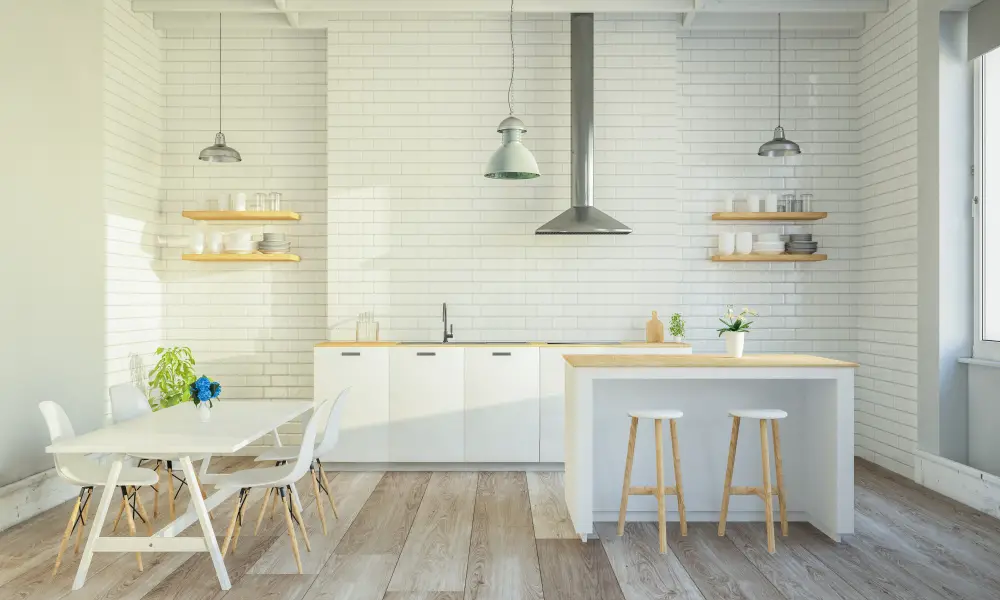
By understanding the basics of interior design, defining your decor theme, and considering furniture styles, you can create a harmonious space that reflects your personal style.
Remember to pay attention to color coordination and texture matching when selecting bar stools and chairs. These elements play a crucial role in creating a cohesive environment.
Consider factors such as height requirements for both seating options to ensure comfort for everyone using them.
When it comes to purchasing bar stools or kitchen chairs, take into account cost considerations while also prioritizing quality. Investing in durable materials will ensure longevity in both functionality and aesthetics.
Lastly, don’t forget about maintenance! Regular cleaning routines will keep your bar stools and kitchen chairs looking their best for years to come.
By following these key takeaways on coordinating bar stools with kitchen chairs – from understanding design principles to making informed choices – you’ll be well-equipped with the knowledge needed to transform your culinary space into an inviting haven where style meets functionality seamlessly.
FAQ
Do bar stools and kitchen chairs need to match?
No, bar stools and kitchen chairs don’t necessarily have to match, it depends on your personal taste in interior design.
What should your bar stools match?
Your bar stools should match the overall decor of the dining area for a sense of unity.
How do you match kitchen stools?
To match kitchen stools, ensure they contrast with your counters and floors, avoiding the same shade or color of floor for wood or metal stools to prevent them from looking too blended.
How can you balance the style of your bar stools with your kitchen design?
Balancing the style of your bar stools with your kitchen design can be achieved by matching their colour, material, and style with the kitchen’s theme.
What factors should be considered when coordinating bar stools with kitchen furniture?
When coordinating bar stools with kitchen furniture, factors such as the style, color, material, height and size of both the stools and the kitchen furniture must be considered.
What are some creative ways to mix and match bar stools and kitchen chairs?
Some creative ways to mix and match bar stools and kitchen chairs include using different styles, colors, or materials, while ensuring the height compatibility and a common design element to ensure cohesion.




